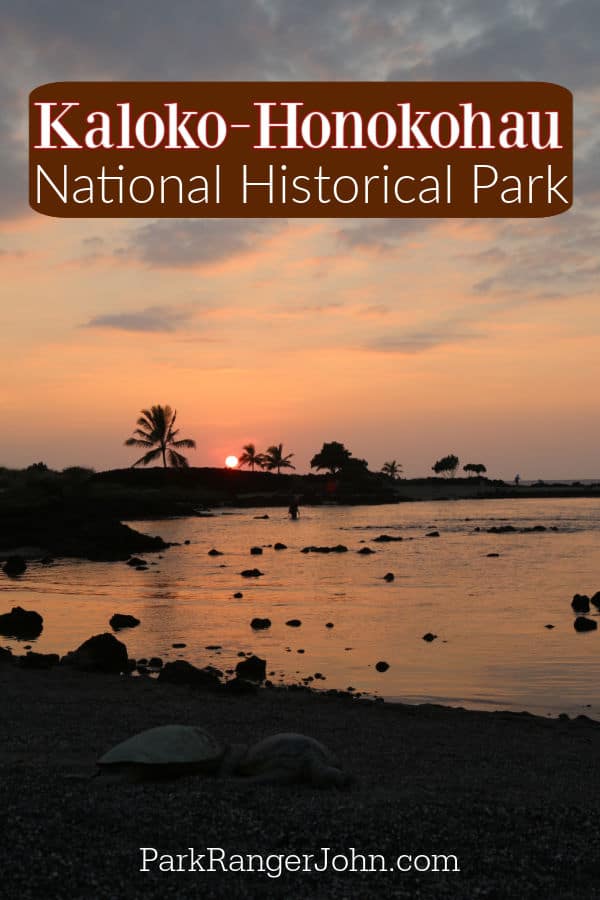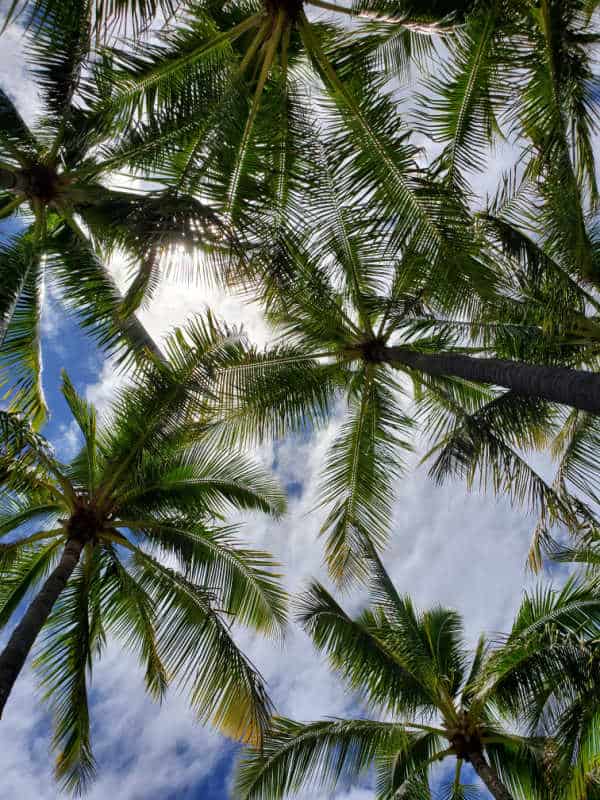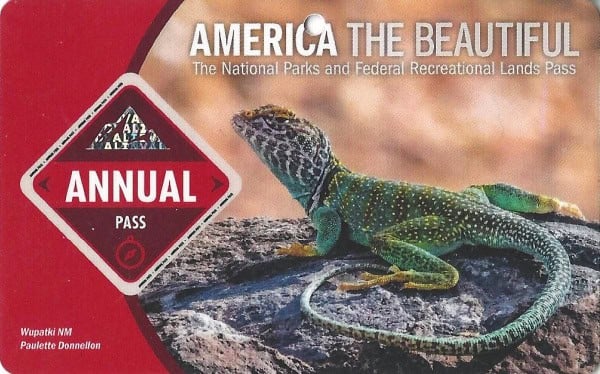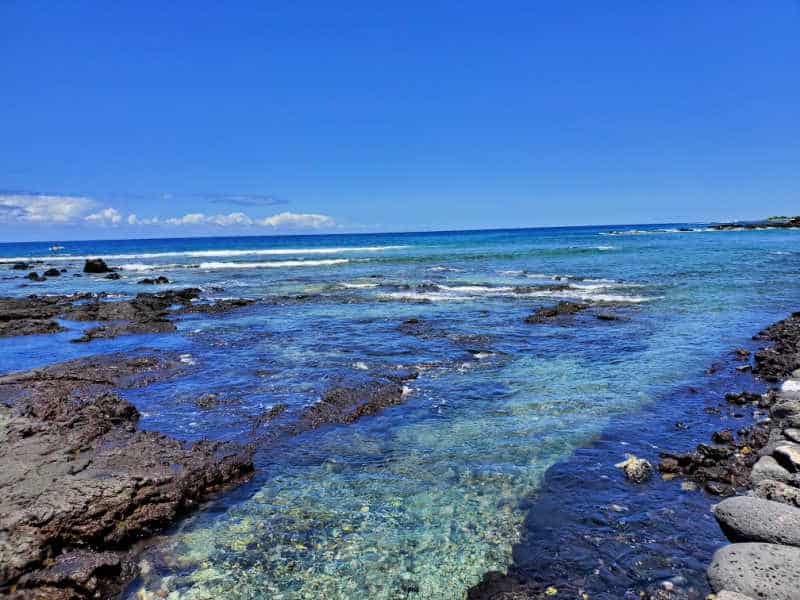Epic Guide to Kaloko Honokohau National Historical Park on the Big Island of Hawaii including things to do, history, epic sunsets, and so much more.

Kaloko-Honokōhau National Historical Park
Kaloko Honokōhau NHP is one of the hidden gems of Hawaii.
This is truly one of our favorite parks in the US National Park system. It is absolutely amazing.
About Kaloko-Honokōhau NHP
Established in 1978, Kaloko Honokohau was created to preserve the coastal sections of two ahupua‘a (traditional land divisions), Kaloko and Honokōhau.
You can hike out and see the largest fish pond wall in Hawai'i which was recently completed in the park. The rock wall is over 800ft in length and 40ft wide and shows how native Hawaiians (kanaka maoli) used fish ponds to survive in this hot arid environment.
The wetland of the Aimakapa Fishpond is an amazing place to look for birds. Early morning is a great time for birdwatching and it gets you out before it gets really hot especially hiking on the black lava.
Migrating birds stop at the wetlands during the winter. Keep an eye out for endangered Hawaiian stilts and coots in the Kaloko Fishpond.

Is Kaloko-Honokōhau National NHP worth visiting?
Kaloko Honokohau is one of my favorite parks in the National Park system! It is extremely easy to access and is located just north of Kona on the Big Island of Hawaii.
You can visit the park's visitor center, go for a hike, go wildlife viewing, and explore the beach.
There have been several times that I have found myself to be one of two people on the entire beach looking out into the Pacific Ocean.
Me and my wife, Tammilee, have found ourselves realizing that we have an entire piece of paradise all too ourselves!
It is also one of the best sunsets you will ever find. Imagine sitting on the beach watching sea turtles sleep in the sand while watching the sunset over the Pacific Ocean with palm trees in the background...truly paradise!

History of Kaloko-Honokōhau National Historical Park
Kaloko Honokohau National Historical Park is located in the Kona district on the big island of Hawaii. It located on the western coast of the island.
The “Big Island” of Hawaii, as it is called, is said to be named as such after the Polynesian explorer who discovered it, Hawai’iloa.
Another theory is that the name stemmed from the native word Hawaiki, which is the place where Polynesian people are said to have originated, the place they go in the afterlife, and the place of their gods and goddesses.
In the late 1700s, Captain James Cook was the first European explorer to visit Hawaii. He nicknamed the collective Hawaiian Islands “Sandwich Islands” after his expedition patron, the Earl of Sandwich.
Cook was killed on the big island in 1779 after a scuffle involving a boat theft.
The Big Island was home to Pai’ea Kamehameha, or The Great Kamehameha, who ruled the islands.
While serving as ruler, and after several years of battles, Kamehameha united the islands together in 1795.
The native Hawaiians settled this rough, jagged, area along the sea as they believed it was a highly spiritual place. They believed that every part of the land and sea in the area evoked a spiritual presence.
The word Kaloko means “pond” and the word Honokohau means “the bay where waters congregate” in Hawaiian.
These two names designated for this Hawaiian Historical Park are the names of two of the four different ahupua’a in the area.
The Hawaiian term ahupua’a refers to a large subdivision of land that usually extends from the mountains to the sea and includes one or more watershed.
Throughout history, each of these areas of land had their own complex socioeconomic system. Each ahupua’a met some need of the greater population in the area. Each had a specific resource they could offer.
A vital resource for generations of natives in this area was fish harvested from the sea and also from fishponds they constructed themselves.
It is believed some of these fishponds were used for more than 600 years. They also grew coconut trees and harvested sweet potatoes as well as raised livestock such as chicken and pigs.
To ensure a thriving spirit in each ahupua’a, those closest to the sea supplied fish, and those more inland grew crops and raised the livestock.
Others would also supply items such as the taro plant and wood. The different groups would then trade with each other what was needed.
Archeologists have long studied the area of this park for its rich history and tight knit community spirit of the natives, surveying over 200 different sites.
The evidence at these sites date back to prehistoric times and on up to historic times.
Archeologists have found evidence of home and religious sites, stone altars and shrines, lava tube shelters in the event of an eruption from the island’s several volcanoes, as well as petroglyphs.
The petroglyphs scattered among the area tell a deeper story into the sense of community and life among the ahupua’as.
The Kaloko Fishpond is an impressive example of the ingenuity and use of the resources that are provided.
The natives first built a lava rock wall in order to separate the bay from the sea. They used special gates, called makaha to control the amount of water that reached the pond and put in place angled walls that controlled the force of massive sea waves.
The lava rocks were porous which also helped control the amount of seawater.
The Kaloko Fishpond seawall was approximately 30 feet wide, 6 feet tall and stretched for 250 yards. In the 1950s the wall was destroyed by storms.
Since that time, the National Park Service has worked with native elders and referenced archeological information to try and reconstruct the wall to the way the natives had built it years ago.
What is visible today is parts of the stonewall as well as the ancient ‘Ai’opio Fishtrap. The walls for this fishtrap were constructed in a way which made it easy for the fish to swim over during high tide.
During low, tide, the fish were then trapped in a specific area and then stored in underwater sections until needed.
The Kaloko Honokohau National Historical Park was established in 1978. The park also includes the National Historic Landmarked archeological site called the Honokohau Settlement.

Things to know before your visit to Kaloko-Honokōhau National Historical Park
Entrance fee
$0.00 - There is no entrance fee to visit the park.
Learn more about National Park Passes for parks that have an entrance fee.
$80.00 - For the America the Beautiful/National Park Pass. The pass covers entrance fees to all US National Park Sites and over 2,000 Federal Recreation Fee Sites for an entire year and covers everyone in the car for per-vehicle sites and up to 4 adults for per-person sites.

Buy your pass at this link, and REI will donate 10% of pass proceeds to the National Forest Foundation, National Park Foundation, and the U.S. Endowment for Forestry & Communities.
National Park Free Entrance Days -Mark your calendars with the five free entrance days the National Park Service offers annually.
Time Zone
Hawaiian Time Zone
Pets
Pets are allowed but must be on a leash at all times.
Cell Service
Cell service really depends on where you are in the park. The visitor center, Kaloko Fishponds, and Ai'opio fish trap normally have good cell service.
Park Hours
Hale Ho'okipa Visitor Center and parking lot are open 8:30 am-4:00 pm daily.
The Kaloko Road Gate is open from 8:00 am-5:00 pm daily. An entrance, which leads to the south end of the park, is reached by following Kealakehe Parkway to the Honokohau Harbor, taking the first right turn and then following the road to the Kona Sailing Club. From here it is a short walk to the beach area.
Visitors are welcome in the park after 4:00 PM, but vehicles must be removed from Hale Ho'okipa Visitor Center parking area.
Wi-Fi
There is no Public Wi-Fi available in the park.
Insect Repellent
Insect repellent is always a great idea when outdoors, especially if you are around any body of water.
We use Permethrin Spray on our clothes before our park trips.
Water Bottle
Make sure to bring your own water bottle and plenty of water with you. Plastic water bottles are not sold in the park.
Parking
There is a great parking area near the visitor center.
Food/Restaurants
There are no restaurants within the park. There are amazing restaurants nearby in Kailua-Kona
Gas
There are no gas stations within the park.
Drones
Drones are not permitted within National Park Sites.
National Park Passport Stamps
National Park Passport stamps can be found in the visitor center.
We like to use these circle stickers for park stamps so we don't have to bring our passport book with us on every trip.
The National Park Passport Book program is a great way to document all of the parks you have visitied.
You can get Passport Stickers and Annual Stamp Sets to help enhance your Passport Book.
Electric Vehicle Charging
There are at least 23 public charging ports in Kailua-Kona

Details about Kaloko-Honokōhau National Historical Park
Size - 1160 acres
Check out how the park compares to other National Parks by Size.
Date Established
November 10, 1978
Visitation
In 2021, Kaloko-Honokōhau NHP had 262,653 park visitors.
In 2020, Kaloko-Honokōhau NHP had 133,877 park visitors.
In 2019, Kaloko-Honokōhau NHP had 232,921 park visitors.
Learn more about the most visited and least visited National Parks in the US
National Park Address
73-4786 Kanalani St., #14
Kailua-Kona, HI 96740-2600
Park phone number: 808-329-6881
National Park Map


Where is Kaloko-Honokōhau National Historical Park?
Kaloko Honokohau NHP is located near Kailua Kona on the Big Island of Hawaii.
Estimated distance from major cities nearby
- Kailua Kona - 3.3 miles
- Waikoloa Village - 28 miles
- Hawi - 49 miles
- Hilo - 77 miles
Estimated Distance from nearby National Parks
Hawaii Volcanoes National Park
Haleakala National Park is located on the island of Maui.
Where is the National Park Visitor Center?
Hale Ho'okipa, the park's visitor center, is open Daily from 8:30- 4:00pm
The visitor center is located off of Queen Ka'ahumanu Highway, south of 97 mile marker

Getting to Kaloko-Honokōhau National Historical Park
Closest Airports
Keahole International Airport (Kailua-Kona Airport) (KOA)
Driving Directions
The visitor center, Hale Ho'okipa, is located half a mile north of the entrance to Honokōhau Harbor.
The Kaloko road gate is located across the highway from the Kaloko New Industrial Park (across from the big yellow "Kona Trade Center" building).

Best time to visit Kaloko-Honokōhau National Historical Park
The best time to visit is anytime you can make it to the Big Island of Hawaii.
Weather and Seasons
Kailua Kona experiences epic warm weather through out the year. There is very little temperature change throughout the year.

Best Things to do in Kaloko-Honokōhau National Historical Park
We suggest planning a few hours minimum in the park. One of our favorite things to do in the park is watch sunset.
We visit the fish ponds and main portions of the park during the day and then head to the harbor for epic sunset views.
Visitor Center
Hale Ho'okipa, is located half a mile north of the entrance to Honokohau Harbor.
Hale Ho'okipa, the Park's Visitor Center has a bookstore/gift shop, interpretive information, a ranger on duty, and great views of the Pacific Ocean
This area is considered sacred and should be protected. Please do not climb on walls, pick plants, get too close to the turtles, or remove artifacts or rocks. This park is here to preserve the culture of the ancient Hawaiians.
Junior Ranger Program
You can pick up a Kaloko Honokohau NHP Junior Ranger program at the visitor center.
Kaloko-Honokōhau Junior Ranger Activity Book (2.12 MB, PDF) (Ages 13 and above)
Children's Activity Book (2.78 MB, PDF) (Ages 3-6)
Are you a slightly older Jr. Ranger, but think you're smarter than a fourth-grader? Then the Kupuna Ranger Book might be for you!
Bird Watching
There is epic bird watching at the Kaloko Fishpond including endangered Hawaiian Stilts.
The Aimakapa Fishpond is a great place to see migratory birds that winter in the park each year.
Camera Gear we use
We are big fans of using great camera gear to get amazing photos while traveling.
Canon R5 - We recently upgraded to the R5 after using a Mark 5 for years. We are loving the camera shutter speed and quality of images.
Canon 100 - 500mm - We use the Canon 100-500 for wildlife photography.
Camera Rain Cover - A rain cover will help protect your camera during rain showers but also when photographing waterfalls.
Camera Cleaning Kit - Cameras can get dirty, beat up, and dusty while in the parks. We like having a cleaning kit with us so we can do on the spot touch ups.
Extra Camera Batteries - We suggest always having one or two extra camera batteries with you. There is nothing worse than going to take a shot and the battery dies.
Extra Memory Cards - We use Extreme PRO SanDisk cards

Hiking in Kaloko-Honokōhau National Historical Park
Always carry the 10 essentials for outdoor survival when exploring.
Within the park you can explore the Mamaloahoa Trail along with the Ala Kahakai National Historic Trail.
Ala Hele Ike Trail will lead you from the visitor center to Honokohau Beach
Don't forget to Pack these Items
Insect repellent is always a great idea outdoors, especially around any body of water.
We use Permethrin Spray on our clothes before our park trips. Please read my article on preventing biting insects while enjoying the outdoors.
Sunscreen - I buy environmentally friendly sunscreen whenever possible because you inevitably pull it out at the beach.
Bring your water bottle and plenty of water with you. Plastic water bottles are not sold in the park.
Sunglasses - I always bring sunglasses with me. I personally love Goodr sunglasses because they are lightweight, durable, and have awesome National Park Designs from several National Parks like Joshua Tree, Yellowstone, Hawaii Volcanoes, Acadia, Denali, and more!
Click here to get your National Parks Edition of Goodr Sunglasses!
Binoculars/Spotting Scope - These will help spot birds and wildlife and make them easier to identify. We tend to see waterfowl in the distance, and they are always just a bit too far to identify them without binoculars.
How to beat the crowds in Kaloko-Honokōhau National Historical Park?
We have visited the park many times and rarely seen a crowd. The best way to beat the crowds is to visit early in the day or stay for sunset.

Where to stay when visiting Kaloko-Honokōhau National Historical Park
There are no National Park Lodges within the park.
There is great lodging and vacation rentals available in Kailua-Kona and surrounding areas.
Courtyard by Marriott King Kamehameha's Kona Beach Hotel - We have stayed at this hotel a few times and it has been fantastic. look forward to a poolside bar, a terrace, and shopping on site. With a beachfront location, beach massages, and beach towels, this hotel is the perfect place to soak up some sun. Indulge in a body scrub, a deep-tissue massage, and a body wrap at The Spa, the onsite spa. Enjoy a meal at the two onsite restaurants. Yoga classes are offered at the gym; other things to do include rowing/canoeing. Stay connected with free in-room Wi-Fi, and guests can find other amenities such as a coffee shop/cafe and a garden.
Westin Hapuna Beach Resort - This is one of our favorite hotels in the world. Take advantage of 18 holes of golf, a grocery/convenience store, and a terrace at The Westin Hapuna Beach Resort. This resort is a great place to bask in the sun with a beachfront location, beachfront dining, and sun loungers. Indulge in a deep-tissue massage, a body treatment, and a body scrub at Hapuna Spa by Mandara, the onsite spa. Be sure to enjoy a meal at any of the 3 onsite restaurants, which feature Mediterranean cuisine and ocean views. The 24-hour gym offers aerobics classes and yoga classes; other things to do include snorkeling, volleyball, and kayaking. Stay connected with free in-room Wi-Fi, and guests can find other amenities such as shopping on site and a coffee shop/café.
Holiday Inn Express Hotel & Suites Kailua-Kona - Free continental breakfast, 9 beach bars, and a terrace are just a few of the amenities provided at Holiday Inn Express Hotel & Suites Kailua-Kona, an IHG Hotel. For some rest and relaxation, visit the hot tub. Free in-room Wi-Fi is available to all guests, along with dry cleaning/laundry services and a gym.
Royal Kona Resort - look forward to a terrace, a garden, and laundry facilities. This hotel is a great place to bask in the sun with beachfront dining and beach massages. Treat yourself to a body treatment, a body scrub, or a body wrap at Lotus Center Spa, the onsite spa. Be sure to enjoy a meal at Don The Beachcomber, the onsite restaurant. Free in-room Wi-Fi is available to all guests, along with 2 bars and a gym.
Aston Kona by the Sea - Guests at this beach condo building will appreciate convenient onsite amenities such as barbecue grills and a picnic area. Each condo provides a kitchen with a refrigerator, an oven, a stovetop, and a microwave. Guests will appreciate conveniences like 2 bathrooms and a washer/dryer, while a TV with cable channels and a DVD player provide a bit of entertainment. Housekeeping is available on request.
Fairmont Orchid - 4.5-star luxury resort by the ocean. At Fairmont Orchid, you can look forward to 18 holes of golf, a beach bar, and a free daily manager's reception. This resort is a great place to bask in the sun with a private beach, beachfront dining, and beach cabanas. Treat yourself to reflexology, a body scrub, or a hot stone massage at Spa Without Walls, the onsite spa. Be sure to enjoy a meal at any of the 4 onsite restaurants, which feature international cuisine and garden views. The health club offers Pilates classes and yoga classes; other things to do include rowing/canoeing, scuba diving, and snorkeling. In addition to a terrace and designer stores on site, guests can connect to free Wi-Fi in public areas.
Click on the map below to see additional hotels and vacation rentals near the park.
Camping
There are no National Park Campgrounds in the park.

Parks Near Kaloko-Honokōhau National Historical Park
Pu’uhonua O Honaunau National Historical Park
Volcano House - Find out what it is like to stay on the rim of the crater in Hawaii Volcanoes NP
Pu`ukoholā Heiau National Historic Site
Check out all of the National Parks in Hawaii along with National Parks in Alaska, California National Parks, National Parks in Oregon, and Washington National Parks.
Make sure to follow Park Ranger John on Facebook, Instagram, Pinterest, and TikTok





Leave a Reply